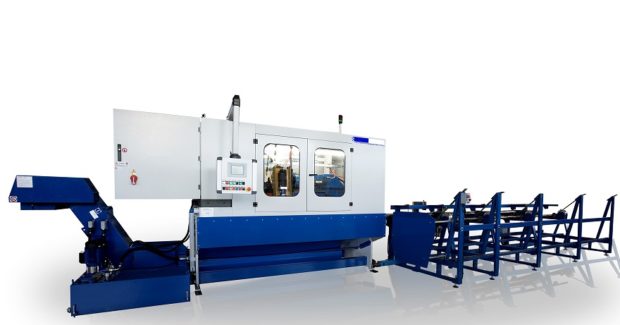Rotary Transfer Tube Machining
Special purpose rotary and linear transfer machines from Suhner can optimize a process with standard or custom systems for each machining application to help shorten overall part cycle times.
Posted: August 22, 2018
Preparation of tubing and pipe generally requires cutting, chamfering, face-off, turning and tapping, including thread milling or thread forming. Combining higher part quantities with these different manufacturing steps demands efficient, time saving production systems to help reduce time and cost. Special purpose rotary and linear transfer machines offer some of the best systems to help shorten overall part cycle times. Using their extensive experience in transfer machine operations, Suhner Industrial Products Corporation (Rome, GA) can optimize a process with standard or custom systems for each machining application. One specific application is for large and long OD threads that require extremely difficult operations, an obstacle to shorter cycle times because an OD threading operation by itself will dictate the overall machine cycle time.
Suhner, in cooperation with Wagner GmbH (Pliezhausen, Germany), a manufacturer for OD thread rolling heads, developed a special process that performs threading in very short cycle times. A pneumatic cylinder-activated system opens and closes the thread rolling head, which is equipped with multiple thread cutting or forming inserts. The workpiece is fed from bar stock material. After a cut-to-length operation, the part is machined – OD and ID and face turning – by three BEX15 machining units, each equipped with a 1.5 kW motor, high precision angular contact spindle bearings and special Weldon tool holders. The most interesting station does OD threading using a BEX35-ISO40 machining unit equipped with a Wagner Z27-2 thread rolling head with integrated inserts. During operation, a CNC slide unit feeds the rotating thread rolling head while the workpiece is stationary. Both the BEX35 spindle and CNC slide are servo-motor driven to synchronize the thread pitch.
When the threading operation is finished, the thread rolling head opens quickly for a fast return to the home position. An internal BEX35 drawbar controlled by a three-position pneumatic cylinder opens and closes the head. This cylinder can make an additional stroke of 10 mm to allow for head and insert adjustments or replacements, depending on thread size. Depending on length, a typical OD thread rolling cycle time ranges between six to ten seconds.
The rolling thread is the forming tool on this machine. The rolling profile is worked in as a parallel peripheral chamfer. Having the same flank lead, various thread diameters either left-hand or right-hand threads can be rolled with the same machine setup. Needle bearings or carbide nuts bear the threads. To tackle the numerous tasks involved, various types and qualities of rolls are available. Roll holders support the thread rolls and fit at the inside of the cam ring. They differ according to the range of diameters and the worked-in lead angles of the thread to roll. Few roll holder sets cover the whole work range of a thread rolling head. It is very easy to replace the roll holders for regular and fine threads, trapezoid and special threads, plus right-hand and left-hand threads.
The thread rolling head supports the roll holders, opens up after the thread rolling and can be positioned precisely according to the rolling diameter. Constructing the proper head is relatively easy. It facilitates controlling the energies of cold forming. The size accuracy and permanent operation of the rolled threads is guaranteed, even with workpieces up to maximum 1,700 N/sq mm of tensile strength. As the connecting element to the machine, the shank isn‘t fitted with operational elements of the rolling head mechanism. This means it can be replaced very easily by thread connections. Various kinds of shanks for almost every tool fitting of the different kinds of machines are generally available. The shank also serves as a die of a stop, should it be needed.
The axially working thread rolling head rolls the superior finish threads in a large working area made possible by the fast and easy exchange capabilities of roll holders that differ in the size of the working area and the holder angle. This ensures that the threads with different profile shapes can be machined with left-hand or right-hand threads using the same head. Other shaping work, such as beading, knurling, rolling-in and smoothing can also be achieved. The heads are suitable for rotating or stationary use. The axial head is closed by radially turning the locking lever or locking roll, or by an automatic locking device. The head’s opening mechanism is activated when the feeding stops, then the rolls release the workpiece. Maximum productivity can be realized by using high precision thread rolls held in place by the roll holders. These can be optimized to match the required pitch, diameter and shape of the rolling thread. The thread roll is the ultimate shaping tool where the profile to be rolled is machined as a parallel circumferential groove.
Suhner Industrial Products Corporation, Hwy 411 South Suhner Drive, PO Box 1234, Rome, GA 30162-1234, 706 235 8046, Fax: 706-235-8045, automation.usa@suhner.com, www.suhner.com/en.




